Abstract
A population based cohort of 144 children weighing less than 2000 g who were without major handicap, and a random control sample of 163 children born at term and weighing over 3000 g were investigated. The aim was to assess the relative importance for cognitive development at 5 years of age, of birthweight, parental demographic factors, and factors related to the environment in which the child was reared. The mean non-verbal IQ was 6.1 points lower (95% CI, 2.3 to 10) for the low birthweight (LBW) group, but the difference was reduced to 4.8 points (95% CI, 1.1 to 8.5) after adjusting for confounding parental demographic and childrearing factors. The verbal IQ was similar for the two groups after such adjustment. Paternal education was the main confounding variable, and demographic factors such as parental education and family income were much stronger predictors of child IQ than birthweight or factors related to the childrearing environment. There was no evidence that the cognitive development of low birthweight children was more sensitive to a non-optimal childrearing environment than that of normal birthweight children. These findings indicate that the risk of impaired cognitive development increases with decreasing socioeconomic status, and that this risk is much larger than, and independent of, the small risk attributable to low birthweight.
Full text
PDF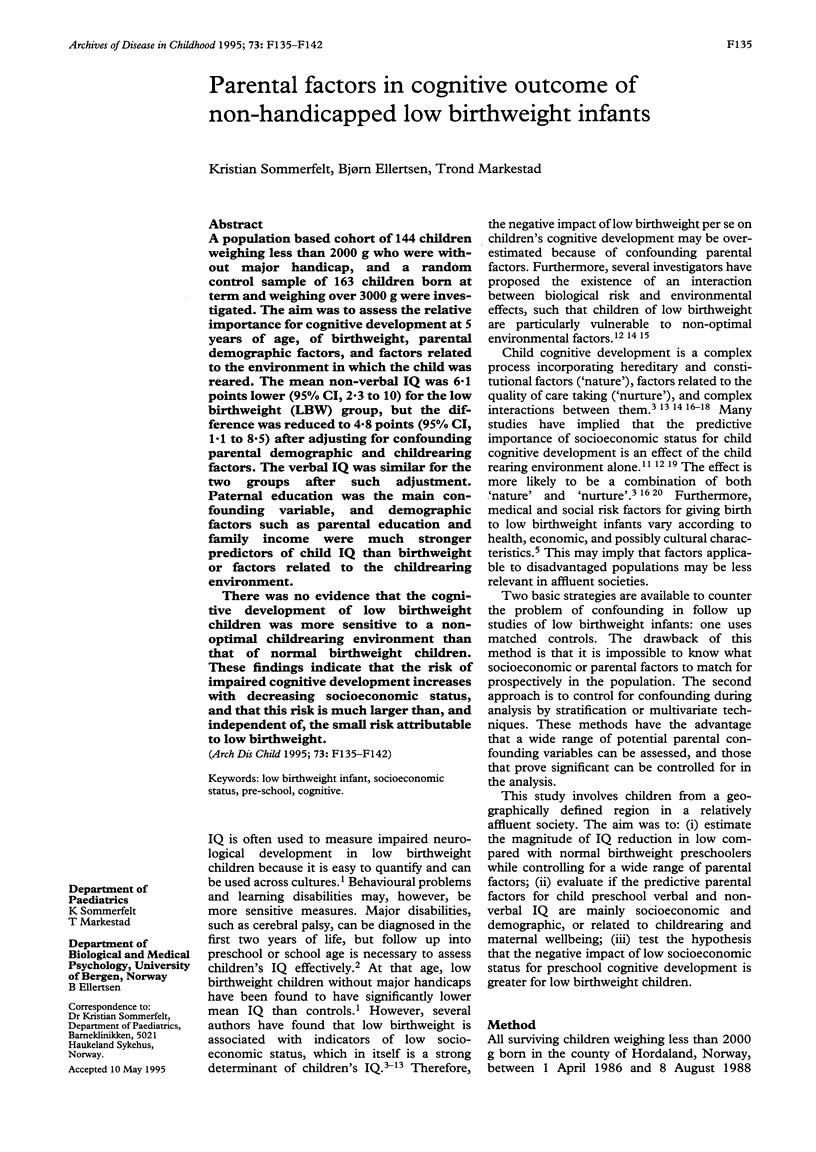

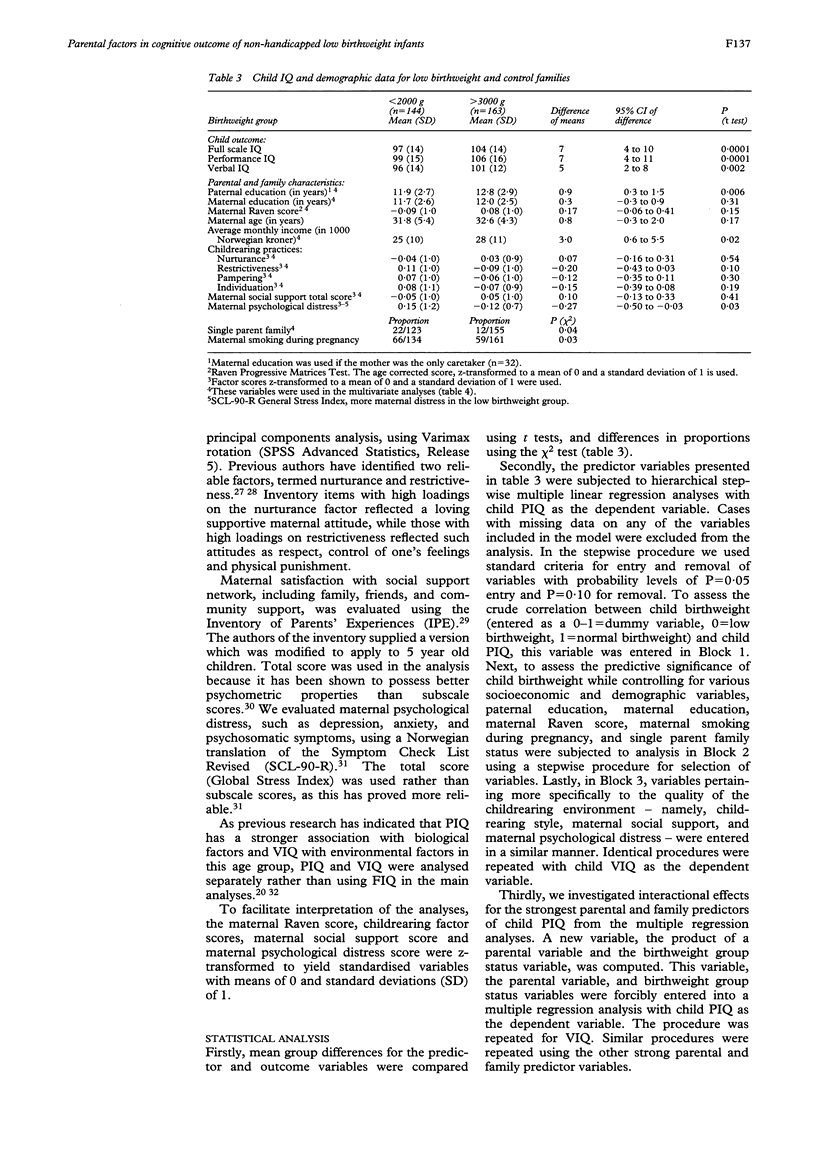
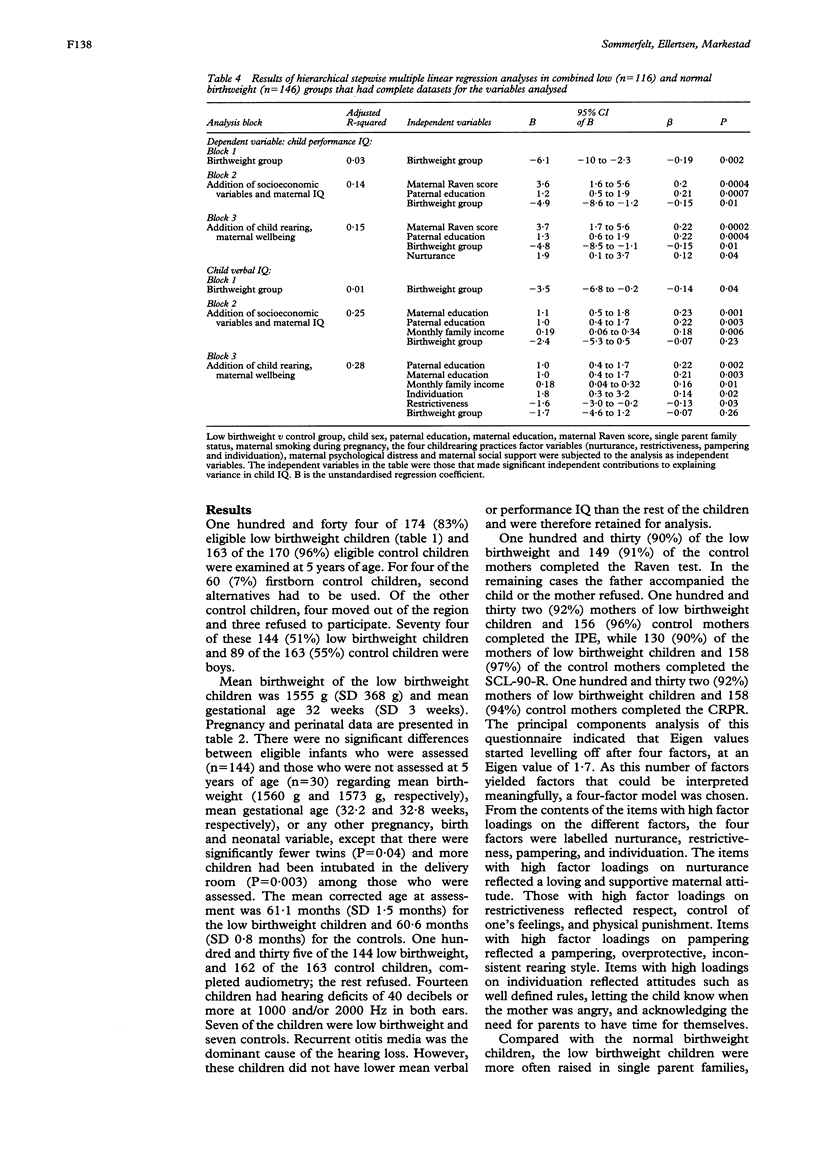
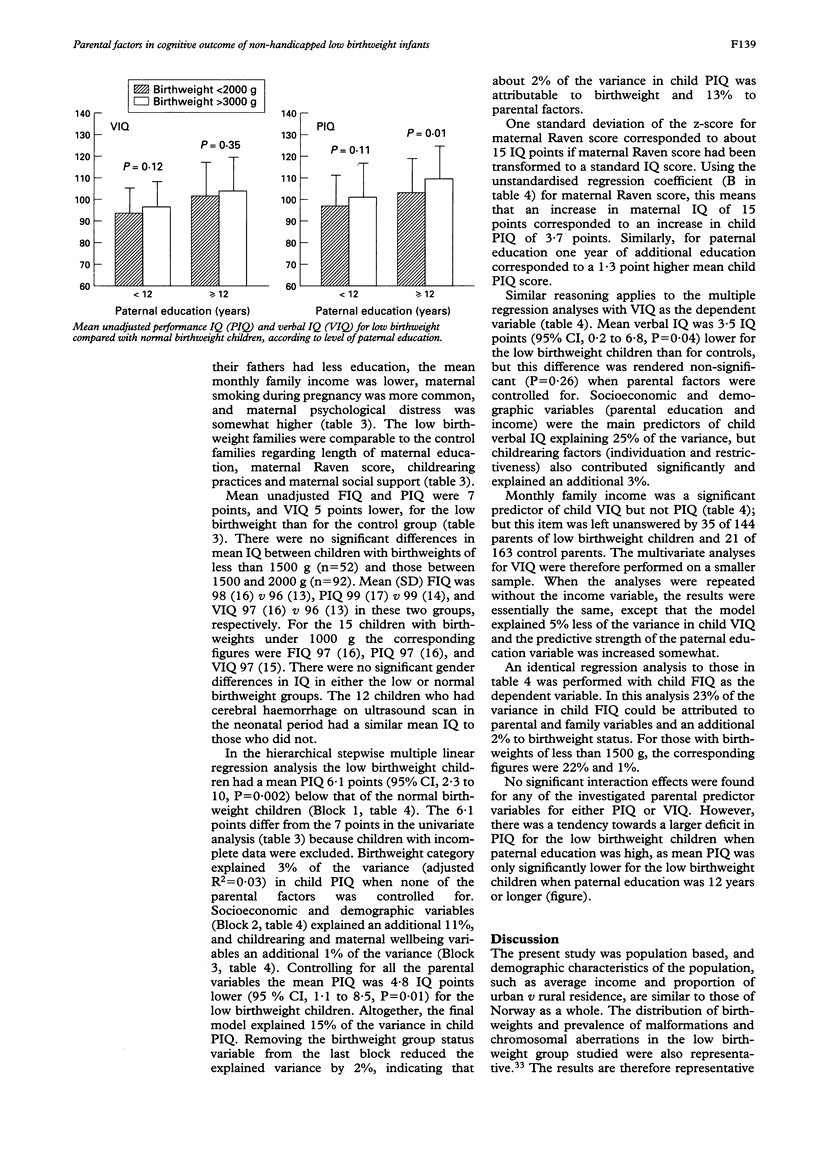
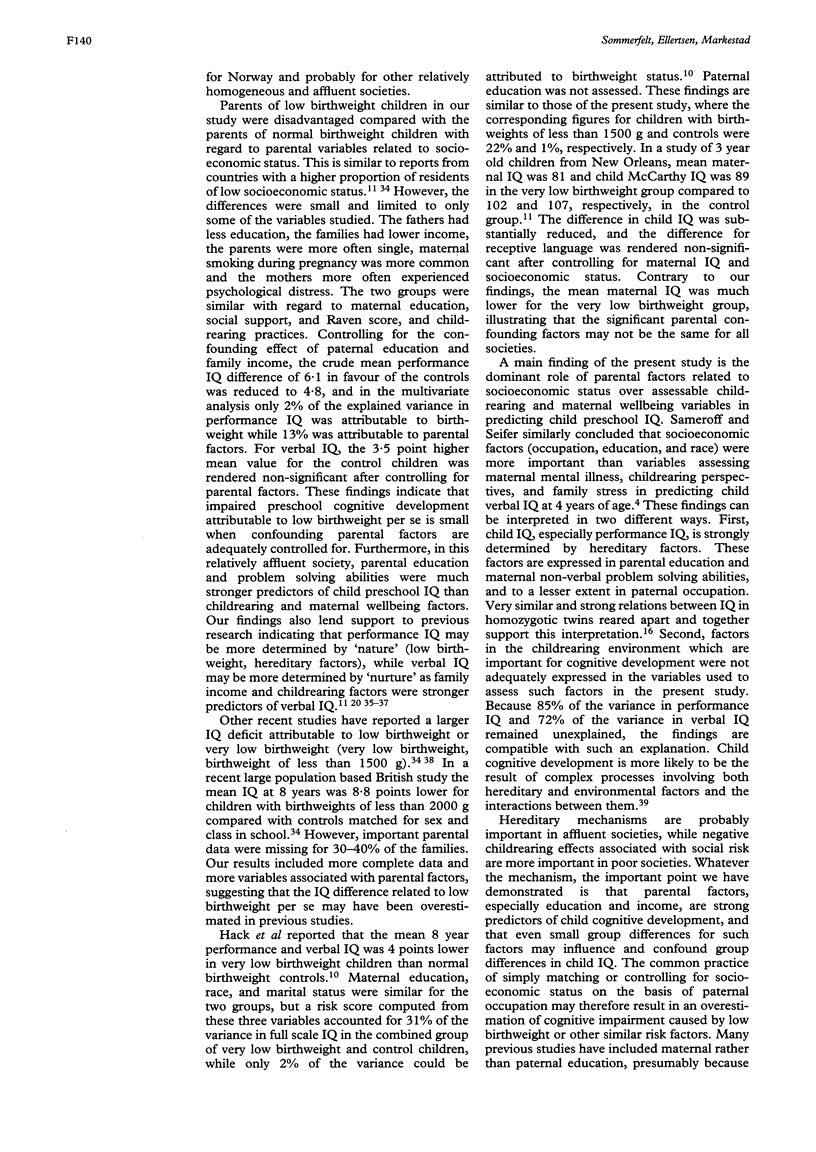
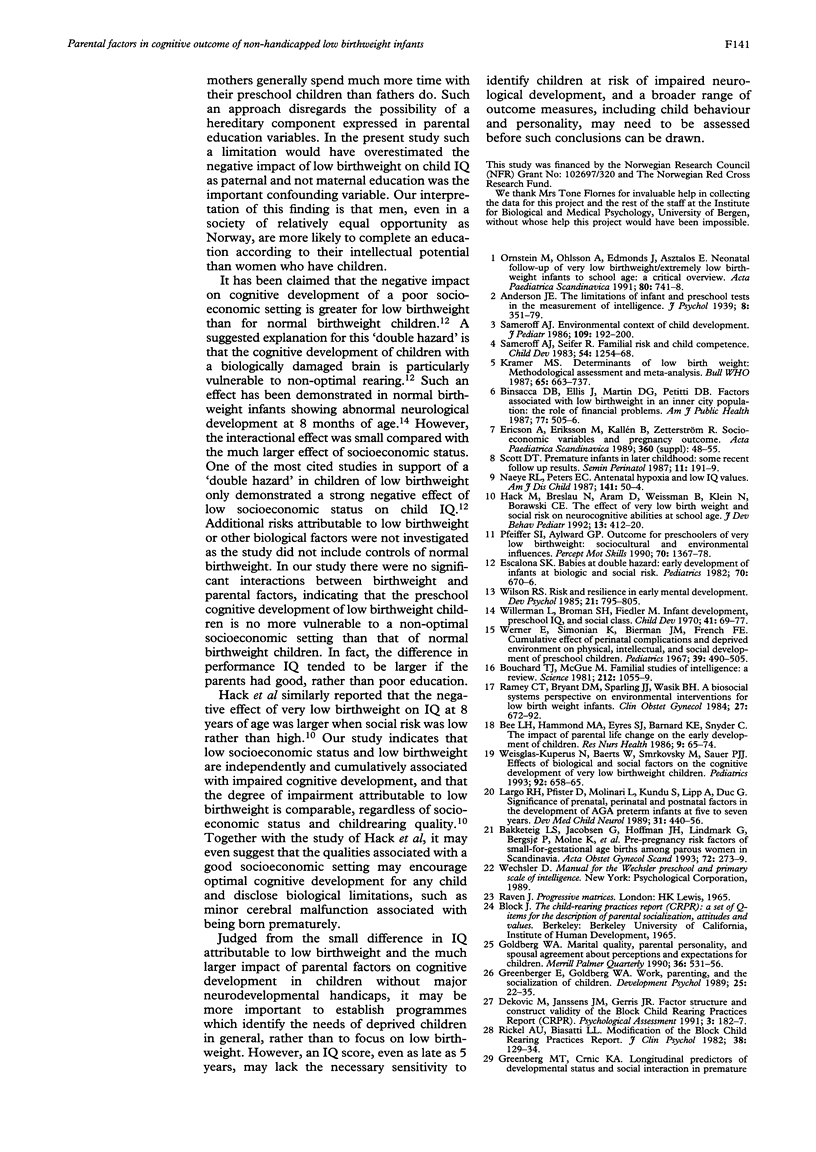

Selected References
These references are in PubMed. This may not be the complete list of references from this article.
- Bakketeig L. S., Jacobsen G., Hoffman H. J., Lindmark G., Bergsjø P., Molne K., Rødsten J. Pre-pregnancy risk factors of small-for-gestational age births among parous women in Scandinavia. Acta Obstet Gynecol Scand. 1993 May;72(4):273–279. doi: 10.3109/00016349309068037. [DOI] [PubMed] [Google Scholar]
- Bee H. L., Hammond M. A., Eyres S. J., Barnard K. E., Snyder C. The impact of parental life change on the early development of children. Res Nurs Health. 1986 Mar;9(1):65–74. doi: 10.1002/nur.4770090111. [DOI] [PubMed] [Google Scholar]
- Binsacca D. B., Ellis J., Martin D. G., Petitti D. B. Factors associated with low birthweight in an inner-city population: the role of financial problems. Am J Public Health. 1987 Apr;77(4):505–506. doi: 10.2105/ajph.77.4.505. [DOI] [PMC free article] [PubMed] [Google Scholar]
- Bouchard T. J., Jr, McGue M. Familial studies of intelligence: a review. Science. 1981 May 29;212(4498):1055–1059. doi: 10.1126/science.7195071. [DOI] [PubMed] [Google Scholar]
- Ericson A., Eriksson M., Källén B., Zetterström R. Socio-economic variables and pregnancy outcome. Birthweight in singletons. Acta Paediatr Scand Suppl. 1989;360:48–55. doi: 10.1111/j.1651-2227.1989.tb11282.x. [DOI] [PubMed] [Google Scholar]
- Escalona S. K. Babies at double hazard: early development of infants at biologic and social risk. Pediatrics. 1982 Nov;70(5):670–676. [PubMed] [Google Scholar]
- Greenberg M. T., Crnic K. A. Longitudinal predictors of developmental status and social interaction in premature and full-term infants at age two. Child Dev. 1988 Jun;59(3):554–570. doi: 10.1111/j.1467-8624.1988.tb03216.x. [DOI] [PubMed] [Google Scholar]
- Hack M., Breslau N., Aram D., Weissman B., Klein N., Borawski-Clark E. The effect of very low birth weight and social risk on neurocognitive abilities at school age. J Dev Behav Pediatr. 1992 Dec;13(6):412–420. [PubMed] [Google Scholar]
- Kramer M. S. Determinants of low birth weight: methodological assessment and meta-analysis. Bull World Health Organ. 1987;65(5):663–737. [PMC free article] [PubMed] [Google Scholar]
- Largo R. H., Pfister D., Molinari L., Kundu S., Lipp A., Duc G. Significance of prenatal, perinatal and postnatal factors in the development of AGA preterm infants at five to seven years. Dev Med Child Neurol. 1989 Aug;31(4):440–456. doi: 10.1111/j.1469-8749.1989.tb04022.x. [DOI] [PubMed] [Google Scholar]
- Naeye R. L., Peters E. C. Antenatal hypoxia and low IQ values. Am J Dis Child. 1987 Jan;141(1):50–54. doi: 10.1001/archpedi.1987.04460010050022. [DOI] [PubMed] [Google Scholar]
- Noble-Jamieson C. M., Lukeman D., Silverman M., Davies P. A. Low birth weight children at school age: neurological, psychological, and pulmonary function. Semin Perinatol. 1982 Oct;6(4):266–273. [PubMed] [Google Scholar]
- Ornstein M., Ohlsson A., Edmonds J., Asztalos E. Neonatal follow-up of very low birthweight/extremely low birthweight infants to school age: a critical overview. Acta Paediatr Scand. 1991 Aug-Sep;80(8-9):741–748. doi: 10.1111/j.1651-2227.1991.tb11943.x. [DOI] [PubMed] [Google Scholar]
- Petersen M. B., Greisen G., Kovacs R., Munck H., Friis-Hansen B. Status at four years of age in 280 children weighing 2,300 g or less at birth. Dan Med Bull. 1990 Dec;37(6):546–552. [PubMed] [Google Scholar]
- Pfeiffer S. I., Aylward G. P. Outcome for preschoolers of very low birthweight: sociocultural and environmental influences. Percept Mot Skills. 1990 Jun;70(3 Pt 2):1367–1378. doi: 10.2466/pms.1990.70.3c.1367. [DOI] [PubMed] [Google Scholar]
- Pharoah P. O., Stevenson C. J., Cooke R. W., Stevenson R. C. Clinical and subclinical deficits at 8 years in a geographically defined cohort of low birthweight infants. Arch Dis Child. 1994 Apr;70(4):264–270. doi: 10.1136/adc.70.4.264. [DOI] [PMC free article] [PubMed] [Google Scholar]
- Ramey C. T., Bryant D. M., Sparling J. J., Wasik B. H. A biosocial systems perspective on environmental interventions for low birth weight infants. Clin Obstet Gynecol. 1984 Sep;27(3):672–692. doi: 10.1097/00003081-198409000-00014. [DOI] [PubMed] [Google Scholar]
- Roussounis S. H., Hubley P. A., Dear P. R. Five-year-follow-up of very low birthweight infants: neurological and psychological outcome. Child Care Health Dev. 1993 Jan-Feb;19(1):45–59. doi: 10.1111/j.1365-2214.1993.tb00712.x. [DOI] [PubMed] [Google Scholar]
- Sameroff A. J. Environmental context of child development. J Pediatr. 1986 Jul;109(1):192–200. doi: 10.1016/s0022-3476(86)80604-7. [DOI] [PubMed] [Google Scholar]
- Sameroff A. J., Seifer R. Familial risk and child competence. Child Dev. 1983 Oct;54(5):1254–1268. [PubMed] [Google Scholar]
- Scott D. T. Premature infants in later childhood: some recent follow-up results. Semin Perinatol. 1987 Apr;11(2):191–199. [PubMed] [Google Scholar]
- Sommerfelt K., Ellertsen B., Markestad T. Personality and behaviour in eight-year-old, non-handicapped children with birth weight under 1500 g. Acta Paediatr. 1993 Sep;82(9):723–728. doi: 10.1111/j.1651-2227.1993.tb12546.x. [DOI] [PubMed] [Google Scholar]
- Vohr B., Garcia Coll C., Flanagan P., Oh W. Effects of intraventricular hemorrhage and socioeconomic status on perceptual, cognitive, and neurologic status of low birth weight infants at 5 years of age. J Pediatr. 1992 Aug;121(2):280–285. doi: 10.1016/s0022-3476(05)81204-1. [DOI] [PubMed] [Google Scholar]
- Weisglas-Kuperus N., Baerts W., Smrkovsky M., Sauer P. J. Effects of biological and social factors on the cognitive development of very low birth weight children. Pediatrics. 1993 Nov;92(5):658–665. [PubMed] [Google Scholar]
- Werner E., Simonian K., Bierman J. M., French F. E. Cumulative effect of perinatal complications and deprived environment on physical, intellectual, and social development of preschool children. Pediatrics. 1967 Apr;39(4):490–505. [PubMed] [Google Scholar]
- Willerman L., Broman S. H. Infant deveolpment, preschool IQ, and social class. Child Dev. 1970 Mar;41(1):69–77. [PubMed] [Google Scholar]


